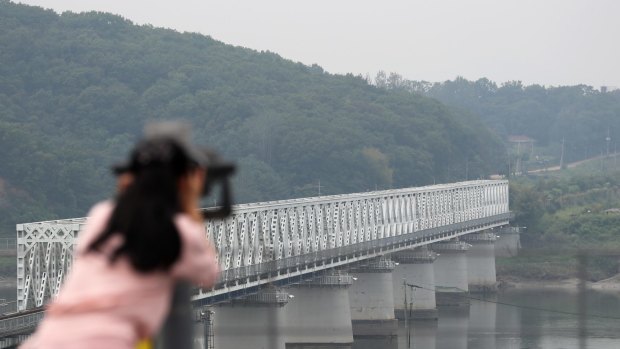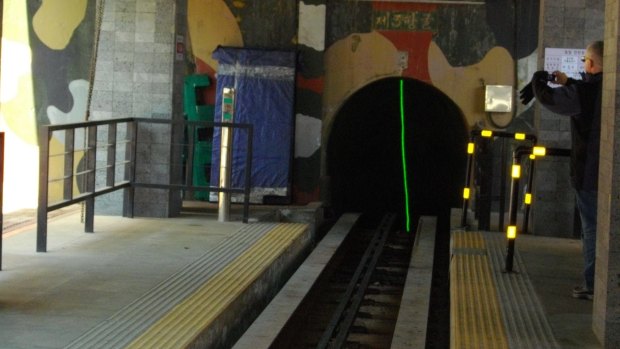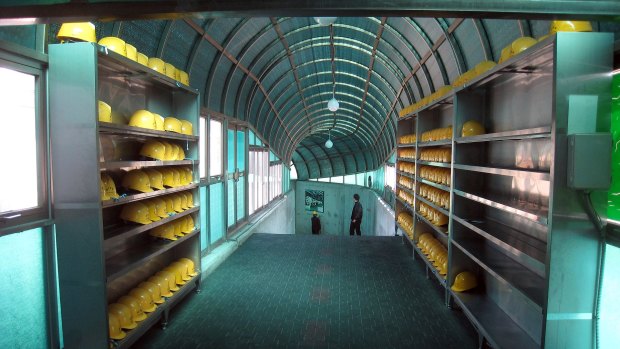This was published 6 years ago
Tourists can explore North Korea's secret tunnels beneath South Korea
By Megan Specia
The tunnels are hundreds of feet below the earth's surface and stretch from the North Korean side of the heavily fortified Demilitarized Zone into neighbouring South Korea.
One was discovered just 32 miles from the South's capital, Seoul.
South Korea says the four passages, called the Tunnels of Aggression, were built to move thousands of North Korean troops quickly and covertly underneath the DMZ and onto South Korean soil for an invasion, an accusation Pyongyang has long denied.

A visitor uses binoculars to look across to the north side of the border at the Imjingak pavilion near the Demilitarized Zone (DMZ) in Paju, South Korea.Credit: Bloomberg
But in the decades since their discovery, some of the tunnels have found new life as a tourist destinations. Thousands of Koreans and foreign visitors explore these odd relics of a frozen conflict, one that is now stressed by renewed tensions and in the spotlight before President Donald Trump's visit to the Peninsula on Tuesday.
The history of the tunnels
During the 1970s, North Korean defectors told officials in the South that President Kim Il Sung had ordered army units to subvert the DMZ by digging tunnels underneath it to prepare for an invasion. Three tunnels were found soon after.

Entrance to the visitor tunnel.Credit: Wikipedia
The first tunnel was discovered in 1974 by a South Korean army patrol, which saw steam rising from the ground and heard suspicious noises. A second tunnel was discovered in 1975. South Korean officials estimated that the second tunnel, which extended nearly a half-mile into their territory, could have accommodated up to 30,000 troops an hour.
In 1978, a significantly larger tunnel was discovered south of Panmunjom, the truce village, another popular tourist spot where military personnel on the two sides of the DMZ come face to face.
A fourth tunnel was discovered in 1990, and while none have been found since, some speculate that dozens have yet to be spotted.

Another entrance to the tunnel.Credit: Wikipedia
What visitors to the tunnels can expect
Tourists in the South are able to visit three of the tunnels through guided tours.
For the equivalent of about $12, according to South Korea's official tourism site, visitors can explore the most popular of the passageways, the "Third Tunnel of Aggression," Dorasan Observatory in South Korea's northwest.
This tunnel was deemed to be the "most threatening as an invasion tool" by the tourism office, because of its proximity to Seoul, just 32 miles away.
The tunnel is 240 feet below the surface. Tourists enter through a gift shop before beginning a steep descent. They wear helmets to protect themselves from the low ceilings.
While tourists can see the North Korean handiwork, what they cannot do is cross the border, as the passage to the North is blocked by concrete slabs.
The DMZ's decades of evolving tourism
While South Korea began its official efforts to bring visitors to the DMZ in the mid-1960s, tourism to the area has boomed since the early 2000s. After the end of the Cold War, it became a place were tourists could see the tension of that era play out in relative safety, said Scott A. Snyder, a senior fellow for Korea studies at the Council on Foreign Relations.
"The rest of the world wasn't on this kind of trigger edge, and yet here was this anomalous place where there were still guns kind of pointed at each other," Snyder said. "But at the same time, it was like a little secret that everyone knew there was not going to be war."
In addition to the tunnels and the village of Panmunjom, ecotourism has become a popular draw for tourists. More than six decades as a no man's land has allowed some endangered species of plants and wildlife to thrive in the DMZ. South Korea's tourism authority says it has "unintentionally become a haven for wildlife."
As threats from both sides have again sparked fears of war on the Peninsula, Snyder urged caution in seeing the DMZ as an artifact of a bygone era and warned that its popularity had potentially negative consequences.
"The danger is that it actually trivialises the threat," he said. "I do think there is this sense that the potential risks of war are in the past and yet the conflict remains unresolved."
He added: "They are seeing a frozen conflict but they aren't necessarily taking it that way because of the tourists elements."
The New York Times
See also: Why I want to visit the world's weirdest country
See also: 143 visits - the westerner that keeps going back to North Korea
Sign up for the Traveller Deals newsletter
Get exclusive travel deals delivered straight to your inbox. Sign up now.